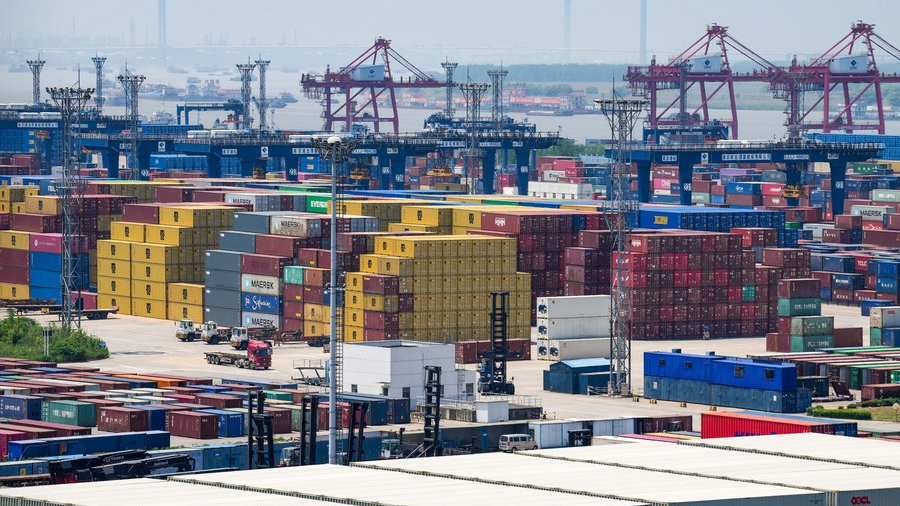
A view of the Longtan Container Terminal of Nanjing Port in Nanjing, Jiangsu Province, May 6, 2022. /Xinhua
A view of the Longtan Container Terminal of Nanjing Port in Nanjing, Jiangsu Province, May 6, 2022. /Xinhua
Editor's note: Guo Lihua is a professor of School of Economics, Minzu University of China. The article reflects the author's opinions and not necessarily the views of CGTN.
At present, the domestic and international environment is complicated. Chinese economic development is facing certain pressures. In this context, how to prevent economic and financial risks and ensure sustained economic growth is a big test.
Pressures combined with the impact of the COVID-19 pandemic have increased economic and financial risks in the near term. These include in-depth adjustment of the real estate industry; risk concentration of local government investment and financing platforms; risks in real economy especially in industry and materials, information technology and internet industries. The above-mentioned risks in the real economy have tended to be transmitted to the financial system, and there have been great fluctuations in the bond market, currency market and other financial sectors.
In-depth analysis show that the core issue of China's economic operation is still the insufficiency of effective demand. Proactive fiscal policy and prudent monetary policy will stimulate domestic demand and expand consumption and investment, which is the internal driving force to solve economic and financial risks.
Over the past year, we have seen the introduction of intensive expansionary policies, which have reduced economic and financial risks in various sectors.
First, sufficient liquidity has reduced overall risks in traditional industries. The COVID-19 pandemic hit the real economy and led to risk spillover, which increased the risk of non-bank financial. However, two reserve requirement ratio cuts have released more than 1 trillion Chinese yuan (about $147.4 billion) of long-term liquidity, and the abundant liquidity in the interbank market reduced the risk of banks.
The hedging effect of the two factors reduced the overall systemic risk level of the financial industry. Ample liquidity has also provided opportunities for the recovery of traditional industries such as industry and information technology, boosting incomes and employment, and thus helping consumption recover.
Secondly, the real estate industry is the top priority for consumption recovery, and the "three arrows" – the latest round of policy tools to support real estate companies including three financing channels: credit, bonds and equity – usher in the dawn of the real estate industry as the policy aims to assist property developers with sufficient financing solutions to ensure the stable development of the sector. The previous "three red lines," which represents three means of credit financing, equity financing and debt financing, have been introduced to solve the liquidity problem of the real estate market. That has indeed helped solve the financing problem to a certain extent.
Meanwhile, the local governments launched a series of policies to stimulate the demand for real estate, such as optimizing the restriction on purchase, sale and loan, which has promoted the rebound of the sales side. The two aforementioned measures help further reduce the current financial pressure on real estate enterprises, and real estate stocks have rebounded sharply in the short term.

A view of Pudong New Area in east China's Shanghai, April 11, 2022. /Xinhua
A view of Pudong New Area in east China's Shanghai, April 11, 2022. /Xinhua
Besides, innovation in the digital economy brings new opportunities. With a market size of 1.4 billion people and sound development of digital infrastructure, Chinese digital economy has achieved rapid growth. At present, China's digital economy is worth $7.1 trillion, ranking second in the world. However, the brutal development of the digital economy in the early stage has brought a series of problems and triggered strict governance measures.
At present, the governance of digital economy has moved from special regulation to regular supervision, and has entered a more standardized and healthy stage. Innovation in the digital economy has brought new forms of economic business and new jobs. It has helped consumption recovery by creating demand through supply.
Moreover, institutional construction provides stable guarantee for preventing economic and financial risks. On April 6, 2022, the People's Bank of China, together with the National Development and Reform Commission and other institutions, issued the Financial Stability Law (Draft for Comment), which is of great significance for stabilizing market expectations and realizing the bottom-line principle of "firmly guarding against systemic financial risks." It has clarified responsibilities of local governments and financial supervision departments, so as to improve the working mechanism.
For institutions with financial risks, the principle of self-rescue before external rescue is adhered to, that is, the shareholders and actual controllers replenish capital for self-rescue, and then search for market means of rescue including market-oriented mergers and acquisitions, deposit insurance funds and industry protection funds. When major financial risks threaten financial stability, the Financial Stability Law proposes to reduce risks through the financial stability protection fund, which is similar to the Orderly Liquidation Fund in the United States and the Financial Market Stabilization Fund in Germany, and this is a good attempt.
According to the resolution of the Central Economic Work Conference, making economic stability our top priority and pursuing progress while ensuring stability will be the main tone of economic work in 2023. For now, the policy will be more aggressive in 2023 than in 2022, aiming to build the foundation for the recovery of consumption and investment. We believe that the economy will grow fairly quickly because of the resilience of the Chinese economy. It's certain that we should also pay attention to some uncertain black swan events and factors, and ensure sustained and stable economic growth through discretionary macro policies.
(If you want to contribute and have specific expertise, please contact us at opinions@cgtn.com. Follow @thouse_opinions on Twitter to discover the latest commentaries in the CGTN Opinion Section.)